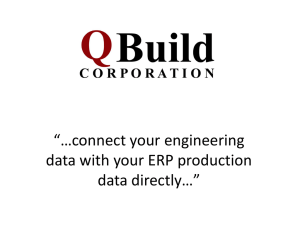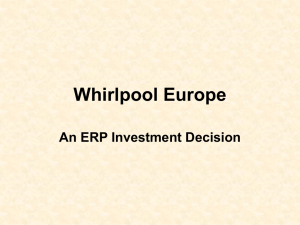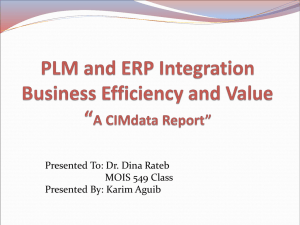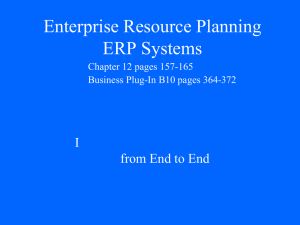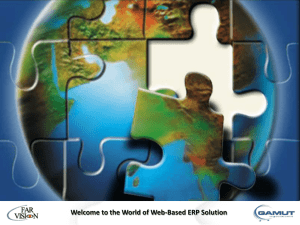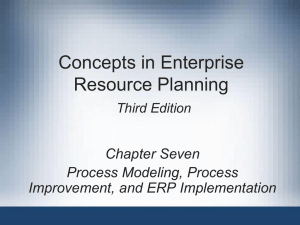Chap7-2 CISB584
advertisement
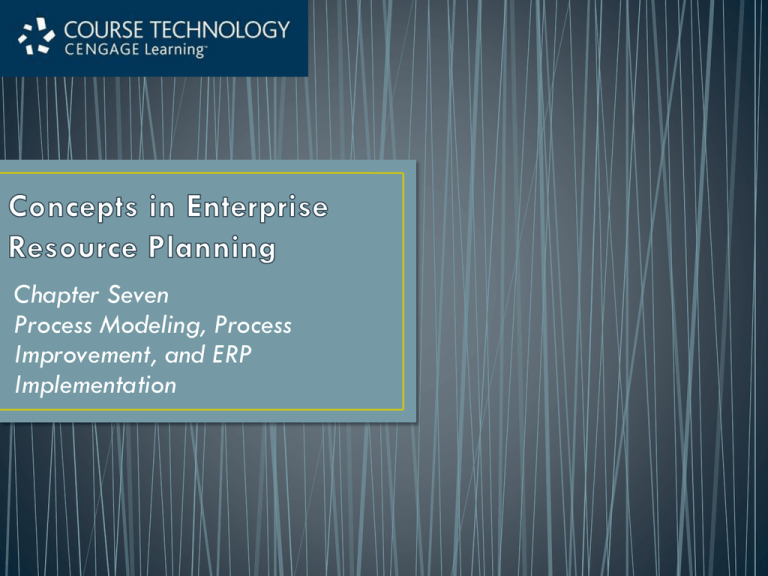
Chapter Seven Process Modeling, Process Improvement, and ERP Implementation • Event process chain (EPC) format • Uses only two symbols to represent a business process • Matches the logic and structure of SAP’s ERP software design • Two structures: events and functions • Events: a state or status in the process • Functions: part of the process where change occurs 2 Figure 7-5 EPC components 3 • EPC software ▫ Enforces an event-function-event structure ▫ Standardized naming convention for functions and events • Three types of branching connectors ▫ AND ▫ OR ▫ Exclusive OR (XOR) • Basic EPC diagram can be augmented with additional information 4 Figure 7-6 Basic EPC layout Figure 7-7 AND connector 5 Figure 7-8 OR connector Figure 7-9 XOR connector 6 Figure 7-11 Possible connector and triggering combinations 7 Figure 7-12 Splitting and consolidating paths 8 Figure 7-13 EPC diagram with organizational and data elements 9 As shown in the example, customer order received as the initial event, which creates a requirement capture within the company. In order to specify this function, sales is responsible for marketing, currency etc. As a result, event requirement captured' leads to another new function: check material on stock, in order to manufacture the productions. All input or output data about material remains in the information resource. After checking material, two events may happenwith or without material on stock. If positive, get material from stock; if not, order material from suppliers. Since the two situations cannot happen at the same time, XOR is the proper connector to link them together. 10 According to an interview, the specific process flow for sales processes is as follows: A customer contact is already available. Customer contact processing is initiated by this customer contact. If the customer shows an interest in the products/services during the customer contact phase, then an inquiry is to be created from the contact, the customer contact can also be unsuccessful. Once the inquiry has been created, the customer inquiry is processed. Alternatively the inquiry processing can also be triggered by the inquiry of a new customer (without reference) being received. During the processing of the customer inquiry, the following events could occur, depending on the prevailing situation: If all the requested products/services are available, the inquiry is recorded in full. Given a possible partial shipment, the inquiry is partially entered. If the required items are not available, the inquiry will have to be rejected, thus terminating the process. In the case of complete or partial entry, the customer offer is processed. This process can lead to the following situations: Either a customer order is received or the customer offer is rejected. If the customer order is received, the Process customer order process is started. The results of the customer order processing can be described as follows: Either the order data are incorrect or the order confirmation is sent 11 • Value analysis • Each activity in the process is analyzed for the value it adds to the product or service • Value added is determined from the perspective of customer • Real value: value for which the customer is willing to pay • Business value: value that helps the company run its business • No value: an activity that should be eliminated 12 • Disrupting the current process to make changes can be costly and time consuming • Dynamic process modeling takes a basic process flowchart and puts it into motion ▫ Uses computer simulation techniques to facilitate the evaluation of proposed process changes • Computer simulation ▫ Uses repeated generation of random variables that interact with a logical model of the process ▫ Predict performance of the actual system 13 • Workflow tools • Software programs that automate the execution of business processes and address all aspects of a process, including: • Process flow (logical steps in the business process) • People involved (the organization) • Effects (the process information) • ERP software provides a workflow management system • Supports and speeds up business processes 14 • Workflow tasks: links that can include basic information, notes, documents, and direct links to business transactions • SAP system can: • Monitor workflow tasks • Automatically take various actions if the tasks are not completed on time 15 Figure 7-14 SAP ERP Workflow Builder screen 16 Figure 7-15 Create notification of absence screen 17 Figure 7-16 Manager’s Business Workplace with workflow task 18 • Workflow provides a number of useful features • Employees can track progress of workflow tasks • System can be programmed to send reminders to employee(s) responsible for a task • For sporadic processes, workflow tools are a powerful way to improve process efficiency and effectiveness 19 • Late 1990s: many firms rushed to implement ERP systems to avoid the Y2K problem • Since 2000: pace of implementations has slowed considerably • Most Fortune 500 firms have implemented an ERP system • Current growth is in the small to midsized business market • Implementation of ERP is an ongoing process 20 • ERP implementation is expensive • Usually ranging between $10 million and $500 million, depending on company size • Costs of ERP implementation • • • • • Software licensing fees Consulting fees Project team member time Employee training Productivity losses 21 • Companies must identify a significant financial benefit that will be generated by ERP system • Only way companies can save money with ERP systems is by using them to support more efficient and effective business processes • Companies must manage transfer of data from old computer systems to new ERP system 22 • Key challenge is not in managing technology, but in managing people • ERP system changes how people work • To be effective, change may have to be dramatic • Business processes that are more effective require fewer people • Some employees may be eliminated from their current jobs 23 • Organizational change management (OCM): managing the human behavior aspects of organizational change • People do not mind change, they mind being changed • If ERP implementation is a project that is being forced on employees, they will resist it • When employees have contributed to a process change, they have a sense of ownership and will likely support the change 24 • Many tools are available to help manage implementation projects • Example: process mapping • SAP provides Solution Manager tool • Helps companies manage implementation of SAP ERP 25 • In Solution Manager, ERP implementation project is presented in a five-phase Implementation Roadmap: • • • • • Project Preparation (15 to 20 days) Business Blueprint (25 to 40 days) Realization (55 to 80 days) Final Preparation (35 to 55 days) Go Live and Support (20 to 24 days) 26 Figure 7-17 Implementation Roadmap in Solution Manager Concepts in Enterprise Resource Planning, Fourth Edition 27 • Project Preparation • • • • Organizing technical team Defining system landscape Selecting hardware and database vendors Defining project’s scope • Scope creep • Business Blueprint • Produces detailed documentation of business process requirements of the company 28 • Realization ▫ Project team members work with consultants to configure the ERP software in development system • Final Preparation ▫ Testing the system throughput for critical business processes ▫ Setting up help desk for end-users ▫ Setting up operation of the Production (PROD) system and transferring data from legacy systems ▫ Conducting end-user training ▫ Setting Go Live date 29 • Go Live and Support • Company begins using new ERP system • Monitoring of system is critical so that changes can be made quickly if performance of the system is not satisfactory • Important to set a date at which the project will be complete 30


